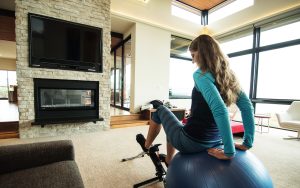Great technology to make the outdoors productive and fun!

While working out can be work, health and fitness technology can make it fun. Technology can even encourage you to be more efficient and achieve your goals. Exercising outdoors is especially appealing when the weather is clear, sunny or cool and refreshing.
For the past few years, I’ve worked out every day. When it comes to outdoor activities, this usually includes year-round walks on streets and trails. During favorable seasons, I may take short hikes and bike rides. I also enjoy playing soccer, basketball or throwing a baseball in the backyard with my son. Depending on the activity, there are many techniques to make the experience more fun. This includes whether you are working out with others or alone.
Wireless earbuds and sports headphones
Jabra Active Elite Earbuds
I take a pair of truly wireless earbuds with me whenever I go out for a walk. You need a pair of headphones that fit securely in your ears and have a clear mode that lets outside noise in when needed. This can be used when you’re running alone early in the morning or late at night. Or conversely, when you’re walking down a bustling street where you can clearly hear cars and other important sounds like ambulances going by.
I downloaded a walking/running playlist. But sometimes, I use wireless data to access streaming music on my favorite services to keep the music fresh. Some Shokz OpenRun headset users prefer to listen to podcasts. Music or other audio can help motivate you to walk faster (or run faster) and maintain a steady pace. It can also help you spend time dancing or singing along, or being fully engaged in a heart-pounding audio interview.
Need more motivation? Some fitness platforms, like Apple and Fitbit, have specialized walking, running and hiking workouts. These include audio instruction, which can make the experience fun and interactive.
Alternatively, some people prefer open-ear headphones, which keep you keenly aware of your surroundings at all times. They are neatly secured on your head or around your neck and sit on your ears. There are also bone conduction headphones, which are worn around your neck and the sound plays as if it were in your ears.
Smartwatch or fitness tracker
Amazfit Band 5
Another piece of tech that I use for my outdoor workouts that doesn’t leave the house is a fitness tracker or smartwatch. Use it to record the specific activity you’re doing and get a summary (and track the data in real time) at the end. This might include how far you walked or ran, how many calories you burned, and your heart rate. Some wearable platforms include a wide variety of specific activities and sports to choose from, such as frisbee, skiing, snowboarding, and Tai Chi. This means you can review exactly what you did and when you did it through the app, which is a fun way to relive your outdoor workouts, as well as see what got your heart rate up the fastest or burned the most calories.
In addition, these devices can track your steps, distance, heart rate, sleep and other important data 24/7. Some can store and play music directly so you can leave your smartphone at home. Serious runners will love this option for getting rid of excess weight.
If you enjoy running, hiking or biking and exploring different terrains, you’ll want to invest in a GPS smartwatch. Why? They’ll track your route so you can save it and go back next time to duplicate it or try something new. This can also help you find your way home if you get lost. Some even have GPS-related safety features so loved ones can find you in an emergency. There are wearables with built-in GPS that can be used on their own, as well as wearables that are GPS-connected, which means they use your phone’s GPS to record data, and you’ll need to have your phone with you in order for them to work.
Polar Heart Rate Monitor Heart Rate Monitor
Most wearables today can track your heart rate 24/7, but some serious fitness enthusiasts opt for specialized heart rate monitors to get the most accurate readings possible. Whether you’re running, doing yoga in the park, enjoying snow sports, or playing squash, a heart rate monitor can provide accurate readings that you can cross-reference with your tracker. Put it on and see how the data compares to your fitness tracker or smartwatch. You can also make sure you’re not overexerting yourself, or vice versa, when you need to kick it up a notch to hit your peak and target heart rate zones.
Cycling computers
Garmin Edge Cycle Computer
If you enjoy cycling, you might like to install a cycle computer on your bike. Use it to keep track of your route and even follow others as you ride. These GPS devices are usually mounted on the handlebars of your bike and track data such as altimeter and even recovery time, hydration and training status.
Most importantly, however, they can display specific tracking content. Not only can you track rides, but you can also choose routes in unfamiliar areas.







